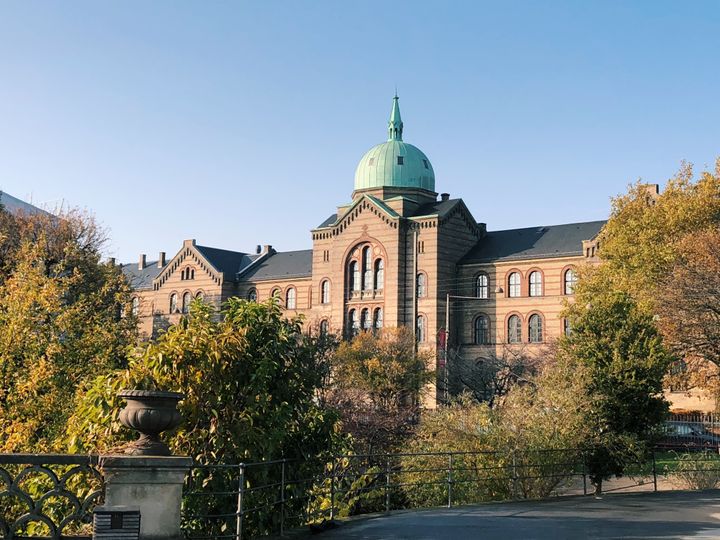Getting Around Copenhagen: A Guide to Transportation Options
Welcome to Copenhagen. From the sleek Metro and S-trains to buses, regional trains, and scenic cycling lanes, the city's transportation system ensures students can easily commute, explore, and embrace vibrant student life.

Welcome to Copenhagen, a city known for its picturesque canals, rich history, and vibrant student life. If you're a student in Denmark's capital, you'll quickly discover that getting around is a breeze, thanks to one of the most efficient and student-friendly transportation systems in the world. Did you know that over 50% of Copenhagen residents commute by bike daily? And with a 92% satisfaction rate among students using public transport, it's clear that the city knows how to keep its learners moving.
Whether you're hopping on the sleek Metro, cruising the harbor on a water bus, or zipping through the city's extensive bike lanes, this guide will help you explore Copenhagen like a local. We'll dive into the different transportation options, uncover some hidden travel hacks, and share how you can make the most of student discounts to keep your journey smooth and affordable. Let's get rolling!
The Metro in Copenhagen
The Copenhagen Metro is an integral part of the city's efficient and modern transportation system, connecting students to universities, vibrant neighborhoods, and cultural hotspots. The Metro operates 24/7, offering unparalleled convenience for late-night study sessions or social outings. Trains run every 2-5 minutes during the day and 3-10 minutes at night, meaning you can reach almost any part of the city quickly and easily. The Metro network has four lines:
- M1 (Green Line): Connects Vanløse in the northwest to Vestamager in the south, passing through key central hubs like Nørreport, Christianshavn, and Islands Brygge.
- M2 (Yellow Line): Shares most of the route with M1 but branches off to the airport at Kastrup, serving popular student neighborhoods like Amagerbro and Ørestad.
- M3 (City Circle Line or Orange Line): A circular line connecting 17 stations around central Copenhagen, including Nørrebro, Vesterbro, and Frederiksberg. Ideal for university campuses.
- M4 (Blue Line): Extends from the City Circle Line at Østerport to the Nordhavn and Orientkaj neighborhoods, soon to expand south to Sydhavn.
For Regular Commuters: The Youth Card
The Youth Card (Ungdomskort) is a special travel card designed to provide discounted public transport for students and young people in Copenhagen and across Denmark. It's available to full-time students enrolled in Danish educational institutions, including universities, colleges, and vocational schools. Both Danish and international students are eligible, provided their course meets the required number of study hours.
With the Youth Card, students enjoy unlimited travel within specified zones at significantly reduced rates, with discounts of up to 50% compared to regular monthly passes. The card covers all forms of public transport, including the Metro, S-trains, buses, and regional trains. It offers flexibility by allowing students to choose zones based on their commuting needs, and it provides nationwide coverage, making it ideal for those who commute between cities.
The Youth Card typically costs between DKK 380 and DKK 600 per month, depending on the number of travel zones selected. It also functions as a regular Rejsekort for pay-as-you-go travel outside the specified zones. Applying for the Youth Card is straightforward. Students can start the application process online via ungdomskort.dk using their NemID or MitID. The process requires personal information, educational institution details, and a selection of travel zones. After submitting the application, the student's educational institution verifies their full-time status, and upon approval, the student receives an email confirmation. The card is then delivered by post.
S-Trains in Copenhagen
The S-trains in Copenhagen form a vital part of the city's public transportation system, offering students a reliable and convenient way to travel between the city center and suburban areas. The network comprises seven lines, labeled from A to H, connecting Copenhagen with its surrounding municipalities and towns, making it particularly useful for students living outside the city's core. These trains are known for their distinctive red color and frequent service, providing a seamless link between neighborhoods, universities, and cultural hotspots.
For students, the S-trains are exceptionally accommodating. They run frequently, typically every 10 minutes during the day and less often at night, ensuring that students can easily reach their destinations, whether for classes or social activities. Many key university campuses and student-friendly neighborhoods are strategically positioned along the S-train network. For instance, students at the University of Copenhagen can hop on the S-train to reach the Nørreport, Nordhavn, or Valby stations, which are conveniently located near different campuses. Similarly, Copenhagen Business School students can use the Fasanvej or Flintholm stations to reach their classes swiftly.
In addition to convenience, the S-trains are an economical choice for students. With the Youth Card (Ungdomskort), students can benefit from discounted fares for unlimited travel within specified zones. The S-trains also allow bicycles for free, providing added flexibility for students who prefer to cycle between the train station and their final destination. This feature makes the S-trains particularly appealing for those living further from their campus but still wanting to maintain an active lifestyle.
Buses in Copenhagen
Buses in Copenhagen are a crucial part of the city’s extensive public transportation network, providing excellent connectivity to areas not directly served by the Metro or S-trains. For students, the bus system offers a convenient and affordable way to reach various neighborhoods, universities, and cultural hubs throughout the city. With over 400 lines crisscrossing the capital, buses help students navigate their daily commute with ease, whether they're heading to class, running errands, or meeting up with friends.
The bus system includes regular daytime buses, night buses, and the newer A-buses, which run frequently and efficiently along key routes. A-buses, identifiable by their bright yellow color, are particularly useful for students, as they run every 3-7 minutes during peak hours and connect major transportation hubs, making it easy to transfer between bus, Metro, and S-train services. Night buses (N buses) are a lifesaver for students who stay out late or have evening classes, as they run when regular daytime buses stop operating. The night buses run every 20-30 minutes, offering peace of mind to students who rely on public transport regardless of the hour.
In addition to regular buses, Copenhagen also boasts the harbor buses, which operate as water buses and offer a scenic commute along the city's canals. While not as fast as other transport modes, they provide a unique and relaxing way for students to travel between neighborhoods like Christianshavn, Nyhavn, and Refshaleøen.
Planning bus journeys is straightforward with the “Rejseplanen” app or website, which provides real-time schedules, route planning, and transfer options. Students can also use the DOT Billetter app to purchase tickets directly from their phones, streamlining their travel experience.
Cycling in Copenhagen
Cycling in Copenhagen is not just a mode of transportation; it's a way of life, and students are particularly drawn to this eco-friendly, efficient, and cost-effective means of getting around the city. With over 390 kilometers of dedicated bike lanes and a biking culture that's deeply ingrained in everyday life, Copenhagen is often considered one of the world's best cities for cyclists.
One of the primary reasons students embrace cycling is the extensive and well-maintained cycling infrastructure. Dedicated bike lanes run alongside most major roads, and segregated bike paths provide a safe environment for cyclists, keeping them separate from vehicle traffic. In busy areas like Nørreport, special cycle bridges like the Cykelslangen (Cycle Snake) and bicycle superhighways streamline commuting between central neighborhoods and suburban campuses. Additionally, many universities offer on-campus bike repair stations and maintenance workshops. For those who prefer not to own a bike, city bike-sharing programs like Donkey Republic and Bycyklen offer flexible rental options with hourly or daily rates, perfect for students who only need a bike occasionally.
Copenhagen's bike-friendly policies further encourage students to cycle. The city offers plenty of secure bike parking spots near universities, dormitories, and Metro stations, making it easy for students to combine cycling with other modes of transportation. Most S-trains and harbor buses allow bicycles on board, enabling students to extend their range and explore neighboring towns or coastal areas.
Regional Trains across Denmark
Regional trains in Copenhagen offer students an invaluable mode of transportation, particularly for those living outside the city or studying at universities in neighboring towns. The regional train network, managed primarily by DSB (Danish State Railways), connects Copenhagen with other cities across Denmark and southern Sweden, making it an essential part of the transportation system for students commuting to universities, internships, or exploring new places over the weekend.
The regional train network is also a boon for international students, offering a direct link between Copenhagen and Malmö in Sweden via the Øresund Bridge. With regular departures every 20 minutes, students can easily travel between the two cities for studies, internships, or leisure. This cross-border service is particularly popular among students at Malmö University or Lund University who reside in Copenhagen or vice versa. The journey takes just over 30 minutes, providing seamless access to educational and cultural opportunities across the region.
Beyond daily commuting, regional trains offer students the chance to explore Denmark's charming cities and picturesque landscapes on weekends or holidays. Popular destinations like Roskilde, Helsingør, and Odense are easily accessible, each offering unique attractions ranging from historic sites to vibrant music festivals. This accessibility enhances the student experience, making it easier for them to enjoy Denmark's rich cultural offerings and natural beauty.
Conclusion
Whether you're cruising on the sleek Metro, hopping onto an S-train, riding the bus, or exploring the city on two wheels, Copenhagen offers a variety of transportation modes that cater to every student's needs. The Youth Card (Ungdomskort) makes commuting even more affordable, providing unlimited travel across the Metro, S-trains, buses, and regional trains at significantly reduced rates. With such an efficient, interconnected transportation system and high satisfaction rates among students, it's clear that Copenhagen excels at keeping its learners moving.
We should probably mention that the absolute best way to learn all about transportation across Copenhagen is to live with someone who's been living there for some time and is somewhat of a Copenhagen expert! Are you looking for a roommate in Copenhagen? Check out our listings on Hemavi.




Comments ()